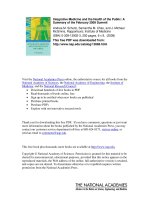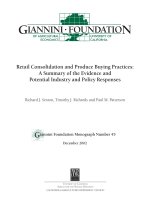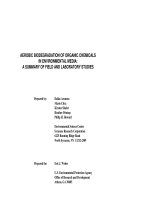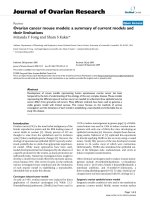a summary of the doctoral dissertation of law the land law of viet nam and of sweden
Bạn đang xem bản rút gọn của tài liệu. Xem và tải ngay bản đầy đủ của tài liệu tại đây (218.43 KB, 36 trang )
FACULTY OF LAW LAW UNIVERSITY OF
University of Lund Hồ Chí Minh city
ĐẶNG ANH QUÂN
TWO LAND REGISTRATION
SYSTEMS – THE LAND LAW OF
VIỆT NAM AND OF SWEDEN
Field of Study: International and Comparative Law
Code: 62.38.60.01
A SUMMARY OF THE DOCTORAL
DISSERTATION OF LAW
2011
2
This research was done at:
LAW UNIVERSITY OF HỒ CHÍ MINH CITY
LUND UNIVERSITY, SWEDEN
SUPERVISORS:
Prof. Hans Heinrich Vogel
Prof. Phạm Hữu Nghị
Discussant 1:
Discussant 2: …………………………………….
Discussant 3:
This dissertation will be presented at ……………….
…………………
Date and time:
This dissertation can be found at the following
libraries:…………………………………………………………
……………………………………
3
Chapter 1
INTRODUCTION
1.1. Background
Based on the implementation of the “open-door” policy and
the concurrent acceptance of the market economy, Việt Nam has in
recent years achieved much both in terms of joining the world
market and in improving social life. Under the impact of the process
of industrialization and modernization, there has been a major
change in the use of major resources such as capital, land and labour
with the focus being on industry and services.
The rules that relate to land have, after a series of
amendments, become crucial to the above process. Land users now
have greater rights to land. Land use rights and the properties
attached to land have become a huge source of capital that the State
and the people use for investing, developing businesses, enlarging
co-operative relationships and attracting foreign investment to Việt
Nam.
However, as the State has had not much experience in
managing this new market, the real estate market in general and the
market in land use rights in particular has developed spontaneously
and outside the State’s control, leading to some negative impacts on
the socio-economic situation. In this context, the problem of how to
manage the real estate market and effectively exploit real property
and correctly orientate its development has become a pressing one.
A number of solutions had been put forward by the
Communist Party and the State in their guidelines and policies. One
of the tools used is land registration, and one thing which needs to be
4
done is the modernization of the system of land registration and
land/real estate information supply in general.
Successful establishment of the land registration system and
the provision of a system of real estate information supply on the
basis of the application of information technology will play an
important role in simplifying administrative procedures; making the
real estate market more and more transparent with full, clear
information on real properties; guaranteeing legal safety for parties
in transactions; limiting disputes regarding land and real estate; and
assisting the State in both managing the real estate market and
preventing lose of tax.
In order to reform and modernize the land registration
system pursuant to the Communist Party’s policies, research on and
appraisal of the current situation of the land registration system needs
to be engaged so that one can truly grasp the shortcomings of the
system. Once this is done, solutions can be enacted and
implemented.
Many research projects have been carried out. However,
most of them focus on technical solutions regarding the
computerization of the management and operation of land
registration activity. Some researches on legal aspects aim at the real
estate market as a whole with little focus on land registration. Such
research as does concentrate on the registration system mainly pays
attention to the problem of real property ownership in general and
does not focus on the fact that land management should be a
foundation for the management of all other types of real property.
Further, they do not determine the essential factors of a land
5
registration system with a view to setting up an effective system,
especially so far as concerns information supply.
What I choose to focus on is evaluating the Vietnamese land
registration system and determining the factors indispensable for its
working. In doing this, I examine useful examples in other
registration systems and the Swedish system in particular is studied
for reasons which will be explained later in this chapter. The title of
my research is thus “Two land registration systems – The land law
of Việt Nam and of Sweden”.
1.2. Purpose
This research has two aims.
First, it defines the fundamental issues of any land
registration system, highlights the benefits of an effective system and
the requirements for it, as well as the factors which can be
considered as its indispensable pillars. Legislators should pay
attention to these issues when reforming the land registration system.
Secondly, the research evaluates the current situation of the
Vietnamese land registration system by way of an analysis of the
legal provisions regulating it and their implementation. This will
allow me, and perhaps other researchers, to make some
recommendations and generally create a body of opinion in favour of
the modernization of the land registration system.
Through this second head, I hope that this research will be
not only a useful and necessary material for public competent
agencies in improving land law and establishing the land registration
system in Vi
ệt Nam, but also a valuable reference material for
studying and teaching law.
6
1.3. Delimitation
The scope of this research is limited to the regulations on the
organization and operation of the land registration machinery; the
regulations concerning the establishment of a registered information
system and the factors which are indispensable to the land
registration system. Although the Swedish land registration system is
mainly focus on here, for some issues I also touch on the experiences
of various other countries. There are, too, many no less important
issues concerning land registration such as land disputes and
effective land registration systems other than Sweden’s could be
studied. However, due to time limitations, I neither can nor aspire to
treat of all these matters in one thesis. Instead, I focus on my
narrower scope with the hope that I will achieve the ends I have
mentioned.
1.4. Method
The method used in my research is a combination of legal
dogmatics, comparison and the methodology of dialectical and
historical materialism. Depending on the topic, each method will be
used either in an appropriate combination with the others or by
taking the key role in the study of a topic.
Việt Nam understands legal dogmatics differently from the way it is
understood in western countries. Legal dogmatics is a method that is used in legal
research in many countries, but when translated into Vietnamese, its name sounds
rather strange. This method tends to analyse, explain and appraise the provisions of a
defined legal system with a view to making recommendations for their development
or improvement. With this meaning made explicit, legal dogmatics is no novelty to
Vietnamese researchers. It is really a rather general name covering the activities of
analysis, evaluation, synthesis, and systematization, each of which is undertaken in
7
research and is more often called by its separate name. I shall however tend to
combine the more specific methods under the one heading.
1.5. Materials
Materials used in this research are both Vietnamese and
English. They are found from many sources such as law, legal
documents, cases, reports of public agencies, books, monographies,
legal reviews and information on internet.
1.6. Outline
Apart from this introductory chapter, my general
conclusions, the annex and the list of reference materials, the
contents of my research will be presented in my four main chapters.
Chapter 2
INTRODUCTION TO LAND REGISTRATION
2.1. The need for a land registration system
Land always plays an important role in all fields of social
life, from the economy, and politics, to culture. It is one of the most
precious natural resources and the highest valuable property. Good
management of land and a sound system of land information are
essential conditions for fostering economic development. So,
creating an effective system of land registration is a necessary
starting point for most countries.
2.2. The central concept and important elements of a system of
land registration
2.2.1. The concept of a system of land registration
Depending on the conditions and situations in each country,
a land registration system can be designed in one of several forms,
but mainly there are two very popular types, namely “land
registration” and “cadastre”. Land registration tries to define the
8
rights and benefit relating to land and will include two types of
registration which can be applied independently or linked to each
other called: deed registration and title registration. The cadastre
focuses on the geometric characteristics of real property units known
as land parcels/units. The purpose of any kind of land registration is
the protection of the right to own or use land and engage in other real
estate transactions. Land registration is usually executed voluntarily
by the land owner/user or other concerned parties. The primary
purpose of the cadastre is setting up a system of land information to
serve the tax collection purposes and only after that it is used in
defining the legality of landholdings. This activity is implemented by
the public authorities.
As society became more developed, the volume of land
transactions increased and the demand for information as well as the
need to confirm and protect land ownership/land use rights become
more urgent; the land registration system establishing land ownership
was then established. It thus supplements and improves the
information already contained in the cadastre.
2.2.2. Important elements of a system of land registration
The key factors of any land unit will be covered including:
(i) the geometry, relating to its physical features and border; (ii) the
legality which specifies the rights and legal benefits attaching to it;
(iii) the value which shows the profitability of the land; and (iv) the
use which shows the way in which land is being exploited.
The four above factors have an interactive relationship with
each other and are indispensable to any effective land registration
system.
2.3.
The benefits of a system of land registration
9
2.3.1. For the land owner/user and related subjects
For land owners/users and other concerned parties, their
rights to and interests in land will be guaranteed. They can use them
to generate capital for investment and improvement of their
economic condition.
2.3.2. For the State
For the government, this system can supply important
information allowing it to set up development policies and serve
other management activities such as land use planning, urban
development, environmental protection and control of the
development of the real estate market. In addition, the system can
support the public taxation system and, incidentally yield a high
income by way of its information services.
2.3.3. For society
For society, a clear system of land information will limit
disputes, stabilize society and guarantee the transparency and speed
up the development of the real estate market. This will lead to the
development of the economy and a decrease in poverty.
2.4. The requirements of a system of land registration
In the light of the above, building an effective system of land
registration is something almost all countries can expect to do or
want to do. And the basic requirements of and key criteria for the
construction of a system of land registration can now be listed.
2.4.1. Accuracy and security
2.4.2. Clarity and simplicity
2.4.3. Timeliness
2.4.4. Fairness and accessibility
2.4.5. Low cost or cheapness
10
2.4.6. Sustainability
Chapter 3
THE SYSTEM OF LAND REGISTRATION IN SWEDEN
– RESEARCH AND EVALUATION
3.1. Outline of the system of land registration in Sweden
3.1.1. The process of setting up the system of land registration
The modern cadastre has deep roots in Sweden. It rests on
old traditions and rules dating from the 13th century, the time of the
oldest written codes. The first cadastral system was created in the
16th century. It was based on cadastral books established by the king
for taxation purposes from 1530 onwards. The making of small scale
cadastral maps was implemented throughout the 17th century and the
early 18th century. Based on this, a title registration system was
established in 1875. Between 1910 and 1930, the registration of all
real estate in Sweden was completed.
The system of land registration in Sweden has thus a long
historical development and key reforms took place in an atmosphere
of peace and stability. It inherits past successes and continues to
improve in the direction of becoming as simple and effective a
system as possible.
3.1.2. Important reforms to the system of land registration in
Sweden
3.1.2.1. Land amalgamation to overcome land fragmentation
It was an extensive programme of land consolidation. It was
taken place in rural areas during the 18th and 19th centuries, and to
an extent in urban ones in the first half of the 20th century. The clear
results of the implementation of this reform were that the number of
fragmented real estate units decreased significantly. The status of
11
ownership increased and subdivision of real estate into new smaller
property units no longer happened so easily. The management costs
incurred by the state and the cost of investing in agricultural and
forestry activities decreased, while tax revenue increased. The
collection, processing and recording of information were carried out
quickly. The natural and cultural environment enjoyed protection.
Boundaries were set and clear and simple conditions of ownership
evolved.
3.1.2.2. Computerization and other new technologies in the system
of land registration
The plan for the computerization of all registration activities
and the issue of combining the data from this system with other state
data was discussed and outlined in the late 60's and early 70s.
A new register that combined land information from
cadastral activities and title registration activities was created and
came into effect in Uppsala in 1974. Then it was expanded to
gradually apply to the whole country. On this basis, a system of land
data banks was set up and completed by 1995. It created the
foundation for the modern information system.
Under technology development, a number of new
information techniques have been applied successfully and makes the
Swedish land registration system one of the most effective digital
systems in the world.
3.1.2.3. Unification of the authority managing the system of land
registration
To simplify the apparatus and unify the management of land
information, the Swedish Government has long sought to modify the
structure and organization of the land registration authority so as to
12
transfer responsibility for the registration of the ownership of land
from the Court to the National Land Survey. The reason for the
decision was that it was considered that land registration would gain
from being concentrated within one government administration.
The process of unification cannot happen in a day and the
Government had to proceed by way of a series of well-prepared
steps. Officially, from June 1
st
, 2008, the National Land Survey
undertook all operations relating to title registration.
3.2. The organization of the system of land registration in
Sweden
3.2.1. The machinery and the staff
3.2.1.1. The machinery
The National Land Survey, with its four professional
division (the Cadastral Services Division, the Land Registration
Division, the Land and Geographic Information Division, and the
Metria Division), takes the main responsibility for registration
throughout the country, including both cadastre and land registration.
3.2.1.2. The staff
Cadastral surveyor and land administrator are the two main
titles of those who carry out activities of land registration in Sweden.
With a long history of reform and development, land
registration officials in Sweden can draw on significant knowledge
and experience in the field. The personnel are always in the vanguard
of developing and applying modern technology to the operations of
surveying and registration in order to benefit the economy and bring
social progress. They play an important role in building and
operating a system of land registration and land information that is
both simple but effective.
13
3.2.2. The procedures for land registration
The procedures for registering land fall into two kinds:
cadastral and title registration.
Cadastral procedures are known in general as acts of real
property formation. They are activities such as subdivision, re-
allotment, amalgamation, partition, property definition and utility
easement procedures etc. Real estate formation procedure is handled
by a cadastral authority and a cadastral surveyor is in charge of it. An
entry concerning property formation or property definition shall be
made in the general section of the Real Property Register at the
earliest possible opportunity after the cadastral procedure has been
concluded.
Land or title registration can also take place at this time,
including the following acts: registration of ownership, registration
of mortgage, title registration of a site leasehold grant, title
registration of a right of user and registration of restrictions on land
etc. It is handled by the land registration offices every weekday.
After a relatively long period of working out how best to
construct a land information system and digitalize cadastral maps,
Sweden unified the cadastral and title registration procedures.
3.2.3. Model and content of registered land information in Sweden
Most Swedish land units have now been registered and the
relevant information fully stated in the Real Property Register which
is operated and managed by the National Land Survey.
The real property register is divided into five basic sections,
namely the general section, the land register section, the address
section, the building section and the tax assessment data section.
14
Besides the cadastral and title information recorded by the
National Land Survey, information about land use planning and land
evaluation is also maintained by the authorities and this is updated
frequently in the Real Property Register.
3.3. Evaluation of the system of land registration in Sweden
With the above success as background, a land data bank
system in Sweden has been set up and successfully digitalized.
Anyone can seek land information over the internet easily, quickly
and conveniently. Applicants can feel comfortable with the
simplified administrative procedures and general convenience of the
system. Many products and services supplied by the Swedish land
registration system meet the demand locally and throughout the
world.
With the rapid development of technology, the National
Land Survey frequently tries to set new targets for its future
development and to determine its weak points with a view to
ensuring the Swedish land registration system has always to catch up
with social demand. And this makes for the success and effectiveness
of the system, an end result which many countries want to emulate.
Chapter 4
THE LAND REGISTRATION SYSTEM AND ITS
RELATION TO THE LAND LAW OF VIỆT NAM
4.1. Outline of land registration system in Việt Nam
4.1.1. Land registration in the former regimes in Việt Nam
4.1.1.1. In feudal periods
Land registration in Việt Nam had been implemented in long
time ago by the Lý-Tr
ần dynasties, from the 11
th
century to the 15
th
century. However, the activities of surveying land and making land
15
map and cadastral book were regulated and carried out officially
since the 16
th
century, under the Lê dynasty.
In the next centuries, because of war and the partion of the
country, land registration activity was interrupted. Not until the first
half of the 19
th
century was land registration activity renewed.
Although the performance of cadastral activities and the
making of a cadastral book in feudal period started very early, nearly
five centuries ago, what was done remained good evidence, the Gia
Long cadastral book in parts of the North and the Minh Mạng
cadastral book in the South of Việt Nam.
4.1.1.2. In the French colonial period
New cadastral techniques were brought to Việt Nam by the
French. The cadastral map was renewed and land title deeds were
used in place of the cadastral book in urban areas. Depending on the
policies in place, the French applied different modes of land
registration in different regions.
4.1.1.3. In the South of Việt Nam from 1954 to 1975
Although the government carried out some land innovations,
the land registration system used was mainly that inherited from the
French.
4.1.2. Land registration established by revolutionary power (since
1945 in the North and from 1975 in the whole)
4.1.2.1. Before 1980
There had been much change in the land regime. However,
these changes had not been registered or recorded. Land information
reflected the actual situation of land by only covering land area, land
use and landowner. There were no procedures for investigating the
16
legal grounds of claims and no history of land use and ownership
existed.
Under the impact of time and continuing changes, the
cadastral files of the old regimes were not updated and ceased to be
used.
4.1.2.2. From 1980 to 1988
At this stage, land registration merely involved the
inventorying of land and the acknowledgement of actual land use.
Because of perfunctory performance, there were errors to be found in
a high percentage of the cadastral files.
4.1.2.3. From 1988 up to the present
When the first Land Law was promulgated in 1987 and came
into effect in 1988
1
, land registration, the establishment of the
cadastral file and issues concerning the land use right certificate were
now laid down officially as part of the State’s administration of land.
However, old cadastral files were not only damaged but
became unsuitable for the new system based on land ownership by
the entire people. Land registration had to be started almost from the
beginning with further changes following development of the
country. Although there have been some achievements in land
registration in recent years, this system has not been so effective in
supporting land administration and exploitation or in supplying
timely and accurate information services to the real estate market.
4.2. Organizing the system of land registration
4.2.1. The machinery and the staff
1
The 1988 Land Law was enacted by the 7
th
National Assembly on
December 29
th
, 1987 and came into effect on January 8
th
, 1988.
17
4.2.1.1. The machinery
The Government shall engage in the uniform administration
of land throughout the entire country; Peoples’ committees at all
levels shall exercise the rights of the representative owner of land
and be responsible for the administration of land in their respective
localities.
Agencies in the Natural Resources and Environment sector
have been established and extends from the central to the grass-roots
level to assist the administrative agencies in carrying out land
administration.
Land registration is regarded as one of the State’s
administrative activities regarding land. It is to be carried out by the
agency of natural resources and environment. Specifically, the Land
Use Right Registration Office which is established at provincial or
district level is to perform this activity.
4.2.1.2. The staff
The cadastral official is a public official who is primarily
responsible for technical and professional activities in the field of
land registration and related activities. Depending on the level of
administrative unit and the rank, there are requirements as to
professional standards which become more demanding as the level
increase. However, whether an official really satisfies all these
requirements depends on the actual situation and the staff already
employed at the level in question.
4.2.2. Land registration procedures
4.2.2.1. Registration unit
Land must be legally registered and established as a
fundamental unit called a land parcel/unit for registration. A
18
parcel/unit of land is a portion of land whose boundary is determined
on site or described in cadastral files. It is formed when the State
grants land use right to land users via the allocation of land, the
leasing of land, and the recognition of land use rights for persons
currently using the land in a stable manner.
4.2.2.2. Circumstances for land use right registration and persons
responsible to register land use right
Land registration or land use right registration in Việt Nam
includes the registration of a land use right for the first time and
registration of any later changes in it.
The persons responsible for register land use right are land
users and the heads of the organizations assigned to manage certain
particular kinds of land.
4.2.2.3. General procedures for land registration
Land registration shall be uniformly applied by the Office of
Land Use Right Registration following the “one-stop” procedure.
The land user only has to submit applications and receive results at
the one authority assigned, in most cases the Office of Land Use
Right Registration. The land use right registration office is in charge
of verifying the files and coordinating with concerned authorities to
resolve any issues. The results of land registration are to be updated
and recorded in the cadastral file managed by the appropriate
authorities.
4.2.3. Construction and management of land information after
land registration
4.2.3.1. Contents of land information
After registration, any land information obtained is to be
included in the cadastral file serving the public land administration.
19
The cadastral file includes a cadastral database and copies of all land
use right certificates. The cadastral database which contains the data
on the cadastral maps, the cadastral attribute data and the note is
archived and managed in digital form at the provincial and district
level, and printed out for use at the communal level.
4.2.3.2. Land information management
The agency of natural resources and environment and the
Land Use Right Registration Office are responsible for land
information management. They carry out revision and update of
cadastral files.
4.2.3.3. Land information supply
Any organization or individual can ask to be supplied with
information in the cadastral files, except for information covered by
the state secret list. The forms of information that can be sought are
stipulated by law.
Private persons seeking information must pay a fee for land
information utilization and supply to the agency managing the
cadastral files but public authorities, political organizations and
socio-political organizations do not have to pay.
Information transfer through the internet has not yet been
implemented yet as there are no networks links between the various
administrative and agencies. Persons seeking information must,
therefore, approach all relevant authorities managing the cadastral
files or residential housing files in person even if they are seeking
land information in different localities.
4.3. Evaluation of the Vietnamese land registration system
4.3.1. The machinery
4.3.1.1. An agency with unstable unification
20
The organization or structure of of the land registration
agencies is often changed. Because of the separation of functions or
mergers within its organizational framework, or because of changes
to its name, functions and obligations, the stability which is
necessary for any administrative authority to perform its tasks tends
not to exist. The responsibility for registration of land use right and
assets attached to land was assigned to the agency of natural
resources and environment and the land use right registration office
just nearly two years ago. As a result, the machinery of land
registration has not been stable yet. It is still in the process of
reorganization.
4.3.1.2. An unstable organization for the implementation of land
registration activity
With uncertain machinery and staff, the land use right
registration office has not yet undertaken its assigned obligations and
tasks. It will take time to train, rotate and reorganize the human
resources in conformity with work demands. The connections
between the administrative agency for land management, the land
use right registration office and the communal cadastral officials are
neither well organized nor timely. Even, in many administrative
units, there is no land use right registration office at district level.
4.3.2. The staff
Many members of the staff of the registration system still
lack professional knowledge, above all regarding information
technology. Further, there is unequal capacity between staff at
different administrative levels. Many are incapable of operating a
modern computerised system. Further, some officials still behave in
a dishonourable and corrupt manner.
21
4.3.3. Land registration procedures and land information
4.3.3.1. General procedures for land registration
The land use right registration office just plays the role of the
assistant liable for managing and recording cadastral files; receiving
applications for land registration; checking and comparing
documents of the applications with the cadastral database; giving its
certification and delivering the files to the appropriate administrative
units at the same level. As the land use right registration office lacks
the right to decide on land registration issues, land registration
procedures are prolonged.
Much important information on the use of land and other real
estate is not registered and recorded. This includes land use rights
attached in order to guarantee execution of a judgment; and
easements over adjoining immovable properties.
There is a separation of responsibility between the land use
right registration office at provincial levels and at district levels
which is based on the type of applicant. As a result, the State
administrative apparatus only became more and more swollen.
Complexity also arises if there is a change in nature of those seeking
registration.
4.3.3.2. The land information system
The technology used for registration and land change
management has not been unified and several different management
software systems are in use. Technical equipment is out of date and
inappropriate for the application of modern information technology
and software to the management of land registration and the updating
of changes. Internal communications are not strong enough to meet
22
the demands imposed by both registration and the supply of
electronic and digital information.
Operation methods have been performed manually in the
past. Cadastral files have been archived in paper form and contain
many errors. There has been overlap and differences in cadastral data
have been archived at agencies at different levels which causes
further difficulties and will increase the time needed for digitalizing.
Registration documents containing many errors have been distributed
and archived and they may also lack some necessary information,
such as cadastral maps and land use right certificates. Furthermore,
due to the non-completion of the establishment of a digital database
and network connection, the provision of archived land information
remains limited and unresponsive to the demands for land
information by both the State and land users. The budget supporting
the reform of the system and the application of information
technology is very low. As a result, work cannot be done
simultaneously on the whole of land registration system in all
localities.
4.4. Assessment of activities regarding land registration
4.4.1. Land use planning
Land using planning has not yet been completed throughout
the country while the new stage of planning, for 2011–2020, is
coming. There has been no effective connection between the land use
plan and the overall plan of social-economic development and the
same holds at field and branch level, especially where the
construction plan and the urban development plan are concerned.
The comments of citizen are not paid attention to and the
promulgation of planning information does not happen. Land using
23
planning is not yet an effective tool for supporting the Government
in land management, and orienting land use activities. It is also not
able to supply complete and correct information to the land
registration system.
4.4.2. Issue of land use right certificates
The issue of land use right certificate, the last stage in the
land registration procedures, is in the same situation. Reform has not
been concluded for many reasons, such as the long dispute between
the agencies concerned; the change in the certificate form; the
complication of the various procedures for the issue of different
kinds of land use right certificate; the late implementation of the law;
and the changes in and lack of cadastral files. As a result, the legality
of many land parcels/units has not yet been ensured which cannot
then become lawful properties in the real estate market. A huge
source of capital is, as a result, stagnant. On another aspect, the land
use right certificate plays a role as an important factor in the
cadastral files and the cadastral database, so the failure to issue such
certificates is also one of the reasons that make the land registration
system unable to improve its information supply effectively.
4.4.3. Determination of land prices
Land evaluation, despite being performed every year at local
level, still has many shortcomings. This leads to embarrassment of
the Government as it is unable to reduce the difference between the
land price approved by the State and market price. Recently, some
effort has been made to ensure that the state valuation of land is
closer to actual market prices and the responsibility for land
determination has been handed over from the financial agency to the
natural resources and environment agency. However, to narrow this
24
gap is not easy even in the developed countries. Despite many
changes, Việt Nam is still faced with an unsolvable problem as the
defined land price applied to compensation for land users whose land
has been compulsorily acquired is supposed to be close to market
price but it also regarded as low when used for calculating the
financial obligations of land users. As a result, the land value
information in the land registration system is failing to help the
Government and other persons exploit land appropriately and derive
the full economic benefits.
Chapter 5
HOW VIỆT NAM CAN IMPROVE ITS LAND
REGISTRATION SYSTEM BY STUDYING AND THEN
COMPARING ITSELF TO THE SWEDISH LAND
REGISTRATION SYSTEM
5.1. The comparison of land registration system between
Vietnamese and Swedish legal frameworks
From the comparison of the land registration system in Việt
Nam and Sweden based on area and population, land registration
machinery, land information system and requirements of the land
registration system, one can see that there are several major
differences between the two systems.
Despite the many gaps, much can still be drawn from the
Swedish land registration system on the basis of a comparison
between the two systems. Furthermore, the core to the success of the
Swedish land registration system is the technical and technological
issue, and the use of modern technology and computerization.
Needless to say, Sweden also spent hundreds of years on designing
and building up its infrastructure, as well as tens of years on applying
modern technology to the registration system before the system
25
reached its present level. Obviously, Việt Nam cannot just copy and
apply these experiences in a young country in a few short years.
However, Việt Nam can study the laws supporting the process and
the computerized model used in Sweden; compare with other
advanced systems of land registration and then select a technical
model which is appropriate to Việt Nam’s specific conditions.
Based on the existing legal provisions regulating the land
registration system, it can be seen that Việt Nam is trying to
computerize the land registration system in order to establish a
modern, electronic, simple and effective system. This is the way that
Sweden had gone. Therefore, the study of Swedish experience
should supply some useful suggestions to Việt Nam when it is
establishing and improving its land registration system.
5.2. Some recommendations for improving the Vietnamese land
registration system
5.2.1. A general recommendation
1. Define the purposes and requirements of the land registration
system which is being established in Việt Nam.
2. Need to anticipate and face with many problems that can be taken
lace during the process of improving and modernizing the land
registration system in Việt Nam, such as issues relating to the source
of investment budget, the support system establishment, and the
responsibility for system management and operation.
3. Evaluate comprehensively and completely current conditions and
situations in Việt Nam, especially the registration machinery and
activity.









